Menu
Download the accompanying materials to this lesson plan - sign up here
Resources and materials for ESL Kids teachers
The present continuous tense (sometimes referred to as the present progessive tense) is often used to talk about a continuing action, something happening now (or at the moment of speaking). It is also used in other situations, such as for temporary events, however, this lesson focuses on the present situation.
The present continuing tense is formed from the present tense to be and the present participle (~ing form) of the main verb:
This is a great energy burning lesson with lots of actions. It introduces the present continuous tense for actions taking place at the time of speaking.
See our "Warm Up & Wrap Up" page.
1. Introduce the actions vocab: play "Slowly reveal the flashcard"
Your students should know some of these actions from previous lessons and possibly your warm-up routine (the "Exercise Routine" activity). This will be a good review and an introduction to some more common verbs.
Before class prepare the following flashcards: run, cook, eat, swim, walk, drink, draw, sleep. You can also add some more action flashcards to this list for more practice.
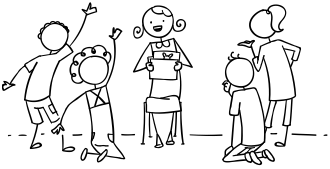 Start with the "run" flashcard – place it behind the pack of the other flashcards so your students can’t see the picture. Slowly push the flashcard up, revealing a little of the picture. Encourage students to shout out what they think it is. Keep slowly revealing the image until someone shouts our the correct word (or for new words you will have to tell them the answer). Then chorus the word 3 times. Finally, shout "Ok, everyone run for 5 seconds … 1 – 2 – 3 – 4 – 5 – Stop!" and have everyone run around as you count five seconds.
Start with the "run" flashcard – place it behind the pack of the other flashcards so your students can’t see the picture. Slowly push the flashcard up, revealing a little of the picture. Encourage students to shout out what they think it is. Keep slowly revealing the image until someone shouts our the correct word (or for new words you will have to tell them the answer). Then chorus the word 3 times. Finally, shout "Ok, everyone run for 5 seconds … 1 – 2 – 3 – 4 – 5 – Stop!" and have everyone run around as you count five seconds.
Then do the same routine with the other flashcards.
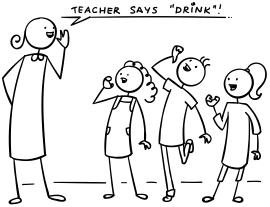 2. Play "Teacher Says"
2. Play "Teacher Says"
This is the same as the game "Simon Says" but with the word "teacher" instead of "Simon". Line everyone up in front of you and say "Teacher says drink" and have everyone do the drinking action. Go through a few more verbs with everyone doing the actions. Then say "sleep" without the "Teacher says" part – anyone who does the action is out! First time, you can give a warning but after that any mistakes result in the student sitting out the round.
3. Introduce the structure – do "Marching Chant"
After playing "Teacher says", keep everyone standing in a line facing you. Place the flashcards on the board in the order of the song (or use the song poster). Model marching on the spot and clapping a slow rhythm and get everybody to copy you – marching on the spot and clapping at an easy pace. Then start the chant in time with the clapping: "What are you doing? – What are you doing? – What are you doing?, etc". Make it so that everyone echoes your chant:
Teacher (chanting): What are you doing?
Students (echoing): What are you doing?
Teacher (chanting): What are you doing?
Students (echoing): What are you doing?
etc.
Next, insert the first action into your chant and have everyone echo as they march and clap along:
Teacher (chanting): I am running.
Students (echoing): I am running.
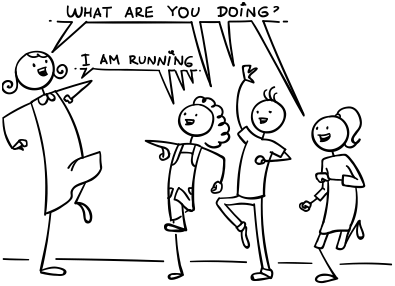 Then add more actions into the chant:
Then add more actions into the chant:
Teacher (chanting): What are you doing?
Students (echoing): What are you doing?
Teacher (chanting): I am running.
Students (echoing): I am running.
Teacher (chanting): What are you doing?
Students (echoing): What are you doing?
Teacher (chanting): I am cooking.
Students (echoing): I am cooking.
etc.
You can have some fun by going fast and slow, adjusting the pace of the marching and the chant.
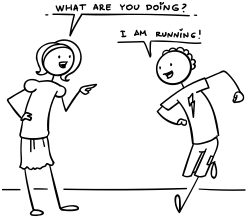 4. Play "What are you doing?" actions
4. Play "What are you doing?" actions
Start by modeling the activity. Get a volunteer to help you. Start running on the spot and have your volunteer say "What are you doing?" and reply "I am running!". Then start doing a cooking action and have the student ask again "What are you doing?". Reply "I am cooking!". Continue this for all of the verbs, in the order of the song, using the flashcards on the board (or the song poster) as prompts.
Next, pair up your students. Have one doing all of the actions and the other asking "What are you doing?". Once finished, students swap roles.
5. Sing the "What are you Doing?" song
By now, you will be ready for the song. Play it through one time and have everyone do the actions and encourage them to sing along (see Gestures for the "What are you doing?" song below). Use the flashcards on the board or the song poster for prompts.
Then play the song once more for fun.
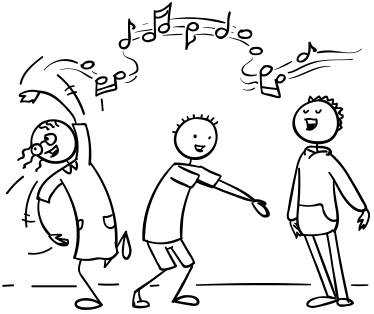 Lyrics for the "What are you Doing?" song
Lyrics for the "What are you Doing?" song
Chorus:
What are you doing?
What are you doing?
What are you doing right now?
Verse 1:
I am running (running!)
I am cooking (cooking!)
I am eating (eating!)
I am swimming (swimming!)
Running, cooking, eating, swimming!
Chorus
Verse 2:
I am walking (walking!)
I am drinking (drinking!)
I am drawing! (drawing!)
I am sleeping! (sleeping!)
Walking, drinking, drawing, sleeping!
Chorus
Verse 3:
I am running (running!)
I am cooking (cooking!)
I am eating (eating!)
I am swimming (swimming!)
Running, cooking, eating, swimming!
Chorus
Verse 4:
I am walking (walking!)
I am drinking (drinking!)
I am drawing! (drawing!)
I am sleeping! (sleeping!)
Walking, drinking, drawing, sleeping!
Gestures for the "What are you Doing?" song
Have everyone stand up for the song. We are going to do all of the actions as we sing, so it will be help to have the song poster or flashcards on the board so everyone can see what actions to do:
We also have a video that you can stream in class to sing along with (Internet connection required):
6. Read classroom reader "What are you Doing?"
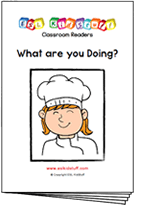 Let's follow the song with a reader which uses the structures from the song. Before class, download and print off the reader "What are you Doing?". As you go through each page, point to the pictures and ask your students what they think the people in each picture are doing, for example:
Let's follow the song with a reader which uses the structures from the song. Before class, download and print off the reader "What are you Doing?". As you go through each page, point to the pictures and ask your students what they think the people in each picture are doing, for example:
Teacher: (reading from page 1) "What are you doing, Sally?". What do you think Sally is doing?
Student A: Riding a bike?
Student B: Taking a bath?
Teacher: Hmm, well let's see ... (turning the page) ... She's running! (Reading) "I'm running".
Some of the pictures are quite straight forward and your students shouldn't have any trouble guessing but others are not so obvious. Get lots of predictions before checking the answers.
After reading the story, give out a reader worksheet to each student and have everyone write what each person in the story is doing. Then go through the answers as a class.
---
Alternatively, watch our video version of the reader (Internet connection required):
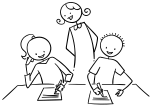 7. Do the "What are you Doing 1?" worksheet
7. Do the "What are you Doing 1?" worksheet
Give out the worksheets and circulate as your students match the sentences to the pictures.
8. Teach "I am, He is, She is, They are"
Start by teaching the following structures on the board:
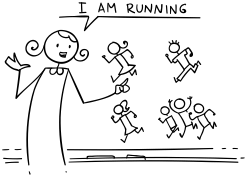 I am running (draw a stick man / woman running and write your name under the picture)
I am running (draw a stick man / woman running and write your name under the picture)Chorus the sentences. Then ask students to come up to the board and draw stick men doing other actions (e.g. "She is drawing", "They are sleeping", "He is swimming", etc.).
9. Do "Magazine cut and paste activity"
Before class you will need to prepare some old magazines, catalogues or newspapers. Anything with pictures of people doing things which you can cut out. The more you can get the better. You’ll also need some large sheets of construction paper.
Start by modeling: hold up a magazine and flick though some pages asking questions about what the people are doing E.g. "What is he doing?" and elicit "He is walking", etc. Feel free to choose pictures with other verbs your students might know (e.g. "She is talking"). For each picture you choose, cut it out and stick onto a large piece of construction paper with the following written in marker pen in the middle: "What is he doing? What is she doing? What are they doing?".
After demonstrating with a few pictures, split your class up into groups – the same number of groups as the number of magazines that you have (3-4 students per group is ideal). Give each group a large sheet of construction paper with the same text written in the middle ("What is he doing? What is she doing? What are they doing?"). Have the groups go through the magazines to cut out and paste pictures of people doing things onto their construction paper. As they are doing so encourage everybody to use the key structures.
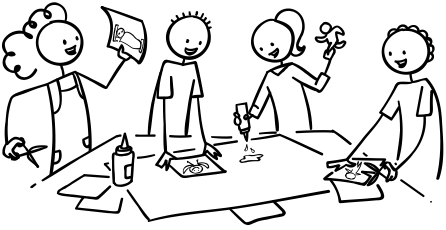
When everyone has finished get one or two students from each group to join a new group. They will then ask questions about the people in the pictures (e.g. "What is she doing?") and the other members need to reply (e.g. "She is riding a bike".).
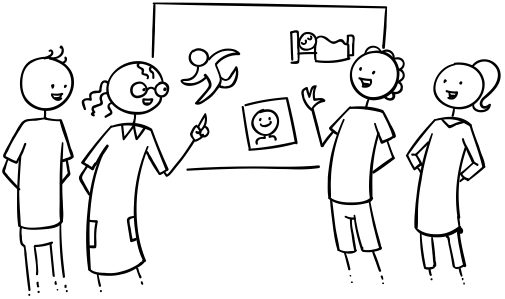
Finally, end this activity by asking questions to each group about their pictures.
1. Assign Homework: "What are you doing? 2" worksheet.
2. Wrap up the lesson with some ideas from our "Warm Up & Wrap Up" page.
 Found a mistake?
Found a mistake?
Please let us know
Full access to all resources on ESL KidStuff including lesson plans, flashcards, worksheets, craft sheets,
song downloads, classroom readers, flashcards app and songs app.